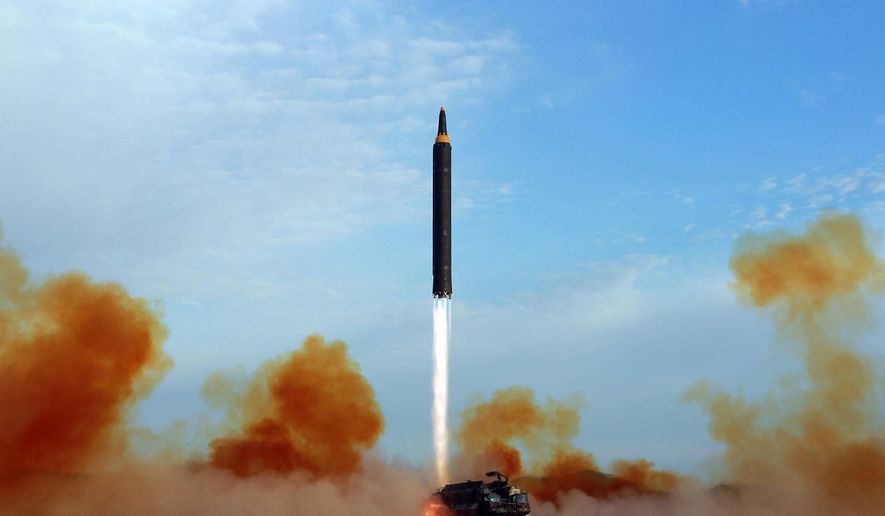Defense Department officials on Tuesday confirmed that U.S. forces in the Pacific detected a potential test launch of a North Korean ballistic missile into the Sea of Japan, which would break a significant lull in Pyongyang’s attempts to field a long-range ballistic weapon.
American military officials “detected a probable missile launch from North Korea” about 1 p.m. EST, Pentagon spokesman Col. Rob Manning told reporters at the Defense Department. He did not provide additional details of the launch, which was the first carried out by the regime since Sept. 15.
“Initial assessment indicates that this missile was an intercontinental ballistic missile,” Col. Manning said in a statement. “The North American Aerospace Defense Command determined the missile launch from North Korea did not pose a threat to North America, our territories or our allies.”
President Trump and his national security staff were briefed on the reported ballistic missile test in real time, as the weapon continued its trajectory toward Japanese waters.
Mr. Trump told reporters Tuesday afternoon that he had a “long discussion” with Defense Secretary James Mattis about the missile launch.
“We will take care of it,” the president said. “It is a situation that we will handle.”
The president said the missile launch adds urgency to a budget standoff with congressional Democratic leaders Sen. Charles Schumer of New York and Rep. Nancy Pelosi of California.
“Things have changed over the last two hours,” Mr. Trump said. “Two hours ago, a missile was launched. I think that will have a huge effect on Schumer and Pelosi. We want strong funding for the military, they don’t.”
He added, “They should be be calling immediately and saying ’we want to see you,’ but probably they won’t. Nothing to them is as important as raising taxes.”
Mr. Mattis said the missile “went higher, frankly, than any previous shot” that North Korea has taken, and that South Korea’s military took defensive action.
“The research and development effort on their part continues building ballistic missiles that can threaten everywhere in the world, basically,” Mr. Mattis said. “In response, the South Koreans have fired some pinpoint missiles out into the water to make certain North Korea understands that they could be taken under fire by our ally. But the bottom line is, it’s a continued effort to build a ballistic missile threat that endangers world peace, regional peace and threatens the United States.”
The missile was reportedly launched from Sain Ni, North Korea, traveling nearly 1,000 kilometers before splashing down in the Sea of Japan, according to the Defense Departmenrt.
The missile reportedly landed inside Japan’s exclusive economic zone, which borders territorial waters contested by Japan, South Korea, Taiwan and China, Japanese defense officials told NHK news.
“We are working with our inter-agency partners on a more detailed assessment of the launch,” Col. Manning said.
Tuesday’s launch comes amid renewed concerns over collaboration between Iran and the North on Pyongyang’s nuclear ambitions.
The Washington Institute for Near East Policy, known for its critical posture toward Iran’s government, says in an analysis that U.S. intelligence has spotted Iranian defense officials in North Korea over the past year — raising the specter that Pyongyang and Tehran might be sharing certain military technological advances with each other.
At least one high-level North Korean visit to Iran has also taken place, according to the analysis published Monday.
“In early August, Kim Yong-nam, North Korea’s number two political leader and head of its legislature, departed Pyongyang amid great fanfare for an extended visit to Iran,” the Washington Institute said. “The official reason was to attend the inauguration of President Hassan Rouhani, but the length of the visit raised alarm bells in Washington and allied capitals.”
• Guy Taylor and Dave Boyer contributed to this article.
• Carlo Muñoz can be reached at cmunoz@washingtontimes.com.




Please read our comment policy before commenting.